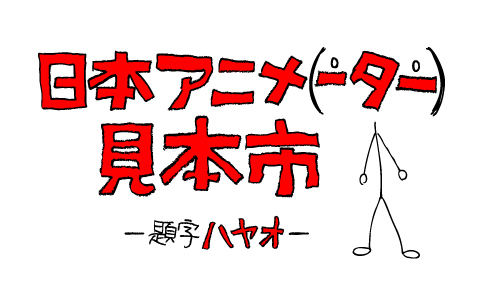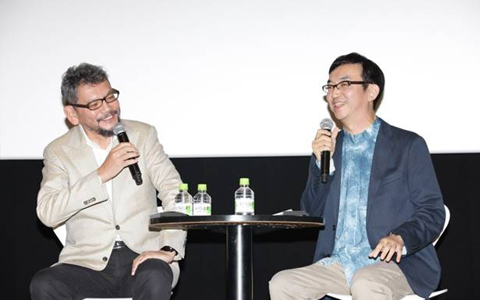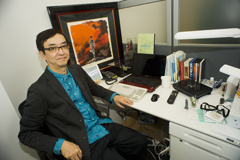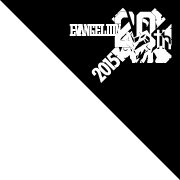The Relation Between Anime and People -- A Journey in Pursuit of its Essence
After a series of involvements with Eva, Hikawa appears in an explanatory program about the Japan Anima(tor) Expo, a joint project launched in November 2014 by Dwango and Khara. It is an experimental attempt in scope of which various directors and staff who carry the anime industry on their shoulders release one short animation every week. After each release, Hikawa explains the piece through talking with the production staff on Japan Anima(tor) Expo -Dou Trace-, a program on Nico Nico Live (every Monday at 10 p.m.).
“You can’t keep on making an anime forever. That’s what “Japan Anima(tor) Expo” is doing, and there’s also the understanding that the explanatory show has the same mindset as that of Eva’s Zenkiroku Zenshuu. Anno was the one who came up with the idea, and it’s really departing from the sense of stagnation toward the future of anime. Since it’s using the functions and name value of Studio Khara that produces Evangelion, I think this might be another part of what links me to Evangelion.”
Through Hikawa’s objective explanations in -Dou Trace-, the audience can further deepen their understanding of making anime and videos. It reflects the happy communication between creator and receiver. The flow of this series of events is repeated every week. Modern day anime fans tend to be buried in an infinite amount of information and evaluate works only on a “material” base instead of a “touching” one. The fun of watching anime - Hikawa keeps on telling us about this primitive feeling we all forgot.
“Animation is made from a fluency of paper drawings in the first place. Why do we find it interesting and touching just because it’s moving? Surprisingly, no one thinks this origin is mysterious, and I think it’s essence is still unknown.
Doesn’t it stand as proof that when we leave the theater after watching an anime, usually all we can remember are the characters and the story? But if that was all it was about, there’s no reason to produce animation at the great monetary cost and the shortening of one’s life, because you can feel the same kind of excitement from a manga or a novel. What’s important is that while in the theater, we are actually experiencing various different anime. That organic bound that was supposed to be in the theater is a momentary miracle, a liberation and resonance of heart. I want to put these things into words to make them last.”
Eva is a story of communication. You could say Hikawa’s research that started from the simple question of “Why do we love animation?” is a journey pursuing the relation between anime and humanity, and the essence of each. Starting from 2014, Hikawa has also taken up teaching as a guest professor at the Graduate School of Meiji University. He is teaching Comprehensive Anime History at the Graduate School of Global Japanese Studies, but it seems that roughly ⅓ of the almost 20 students who signed up for your class in 2014 were foreign students.
“The most interesting thing here is that the video communication of anime is also understood internationally for some reason. Not only us, people from all countries say, “Moe!” at large-eyed girls dressed in sailor uniforms. If it’s already crossed the barriers of language and culture and is mutually understood, doesn’t that make it an ultra international culture? If one were to ask whether the same thing could be done with Japanese live action films, I don’t think it can. Anime’s fearsome ability of transgressing borders also means that us creatures called humans are built roughly the same way. If that’s the case, there’s even a possibility for crossing the borders between nations and sharing sympathy through anime. I think something huge is happening that connects to world peace. Somehow, before I die, I want to get to the end of the unknown potential of anime and the truth that touches people so deep.”

The title letters were created by Hayao Miyazaki from Studio Ghibli. The plan for the “Japan Anima(tor) Expo” was proposed by Anno, and it’s still being distributed online by Dwango. The first piece released in November 2014 was director Tsurumaki’s. Since then, creators bearing the future of the anime industry have been showing their powers of imagination and popular techniques crossing the wall between studios. At present, it’s running its second series with one new title released every Friday, and the explanatory program Japan Anima(tor)’s Expo -Dou Trace- in which Hikawa appears is released on Nico Nico Live the following Monday.

At the Tokyo International Film Festival held in October 2014, there was a special screening of Anno’s works. Tickets for all days sold out as the fans came running not to miss the chance of being able to see past masterpieces and surprising, rare pieces on a big screen. During the festival, Anno himself appeared in talk events on five nights, creating a sensation, and night after night, Hikawa played the role of the listener. During these events, the service-oriented Anno looked back on half his life and was very talkative about his works. This was likely due in large part to his trust relationship with Hikawa.
© 2014 TIFF (Photo cooperation: Tokyo International Film Festival)

Meiji University Graduate School Guest Professor
Anime and tokusatsu researcher
Ryusuke Hikawa
Official Blog: Ryusuke Hikawa’s Blog
http://hikawa.cocolog-nifty.com/
Official Twitter
https://twitter.com/ryu_hikawa

